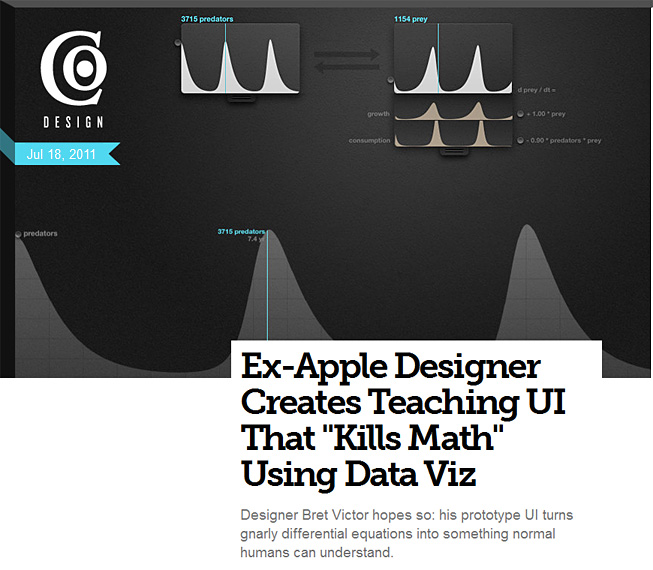New stats: Book publishing is growing; e-book revs and sales up over 1000% — PaidContent.org
The changing landscape for e-textbooks and LMS platforms in higher education — from blog.xplana.com by Rob Reynolds
Also see:
- Emerging Trends in LMS / Ed Tech Market — from Michael Feldstein
From Brett Victor’s “Kill Math” page
The power to understand and predict the quantities of the world should not be restricted to those with a freakish knack for manipulating abstract symbols.
When most people speak of Math, what they have in mind is more its mechanism than its essence. This “Math” consists of assigning meaning to a set of symbols, blindly shuffling around these symbols according to arcane rules, and then interpreting a meaning from the shuffled result. The process is not unlike casting lots.
This mechanism of math evolved for a reason: it was the most efficient means of modeling quantitative systems given the constraints of pencil and paper. Unfortunately, most people are not comfortable with bundling up meaning into abstract symbols and making them dance. Thus, the power of math beyond arithmetic is generally reserved for a clergy of scientists and engineers (many of whom struggle with symbolic abstractions more than they’ll actually admit).
We are no longer constrained by pencil and paper. The symbolic shuffle should no longer be taken for granted as the fundamental mechanism for understanding quantity and change. Math needs a new interface.
Also see:
Teaching secrets: Teaching students how to learn — from Edweek.org by Cossondra George
Excerpt:
Awareness of common pitfalls and effective strategies can support your efforts to help students “learn to learn” throughout the school year…
From DSC:
I sure wish instructional designers, subject matter experts, professors and teachers could annotate their “books” to give concrete, practical ideas and strategies that would help students to better study, understand, and remember the relevant materials. My early take on this might be achieved via a multi-layered, digital textbook approach that would hopefully address metacognition and help students learn how to learn:

What the Kindle textbook rental program portends for higher education — from xplana.com by Rob Reynolds
Excerpt:
Almost as soon as the press release hit the Internet yesterday, I began fielding questions about Amazon’s new Kindle textbook rental program. What does this mean for publishers? How will this affect textbook prices? What impact will it have on institutions and their students?
While the general answer to all of these questions is “We don’t know yet,” there are a number of projections I think we can make based on current market trends. Before launching into those projections, however, let’s take a quick look at what the Kindle textbook rental program actually offers.
Borders forced to liquidate, close all stores — from the WSJ by Mike Spector and Jeff Trachtenberg
Also see:
- Borders to close all remaining stores — fromThe Loop by Peter Cohen
From DSC:
Another example — like Blockbuster — of a company who underestimated the disruptive power of technology.
Amazon rolls out textbook rentals for Kindle, promises discounts up to 80 percent — from by Donald Melanson
- Textbook rentals come to the Kindle: Probably not a money-saver — from ReadWriteWeb by Audrey Watters
Digital Book 2011 – presentation slides now available — from International Digital Publishing Forum (idpf.org)
Presentation slides from IDPF Digital Book 2011 at BEA (May 23-24 2011) can be downloaded from links in each speaker’s biography.
Also see:
- Introduction to e-books — from JISC
This guide discusses the various types of electronic book (e-book) and ways to read them. It also discusses some key design considerations for e-book production and introduces the types of multimedia file formats that can be supported.
Check out:
- Fantastic new children’s iPad book by author William Joyce — from curiositycounts.com as curated by Maria Popova
Also see:
- iTunes Preview of “The Fantastic Flying Books of Mr. Morris Lessmore” by Moonbot Studios LA, LLC
- The Making Of Morris: Part 4 (Invitations To Adventure)
- The Making Of Morris: Part 3 (Thousands Of Books)
- morrislessmore.com
- MOONBOT Studios: An interplanetary creative expedition of story and art
From DSC:
This also nicely illustrates why I believe we need to use teams of specialists to create and deliver our learning materials (June 2009).
Royal Holloway to validate publisher Pearson’s degree — from the BBC
- Publishing giant Pearson has announced a partnership with Royal Holloway university that will allow it to enter the degree market.
- The university is to validate a degree in business, developed by Pearson, which says it eventually wants its own degree-awarding powers.
- A White Paper last week outlined government plans to allow the expansion of private degree providers.
- But the lecturers’ union warned of a possible focus on profitable courses.
- Pearson said the degree would be available from September 2012.
- It said it was in talks with further education colleges, which would teach the course.
From DSC:
Many of the publishers already have teams of specialists in place; i.e. they’ve already set their tables (see the graphic I created below that represents where I believe ALL institutions of higher education need to get to — and as quickly as possible).

Publishers launch first digital-only textbook for K-12 — from Mashable.com by Sarah Kessler
Excerpt:
McGraw-Hill launched its first all-digital, cloud-based textbook for the K-12 market on Monday at the International Society for Technology in Education (ISTE) conference.
Unlike the company’s previous digital efforts for this age group, the books are intended to be used as primary texts (other McGraw-Hill digital texts have been sold as a companion of physical textbooks). This is the first time a major publisher has launched such a platform.
JK Rowling creates transmedia storytelling site Pottermore.com, dumps Amazon — from psfk.com by Piers Fawkes
Many of you have seen this already, but I just got back from vacation and I want to document this event.
LinkedIn leaps (further) into the content game with SlideShare –– from FastCompany.com by E.B. Boyd
Excerpt:
Everyone knows LinkedIn as a networking tool. But slowly, it’s becoming a media publisher too–or at least a place to find great work-related content.
Back in March, Reid Hoffman’s crew launched LinkedIn Today, a way for businesspeople to share and discover great articles. Today, it announces a tighter integration with SlideShare, so folks can share and discover presentations, videos, and documents from that site.
Onswipe launches tablet publishing platform with Hearst, Slate, Ziff Davis, Forbes and more — from Onswipe.com
Excerpt:
NEW YORK CITY, N.Y. (June 21st, 2011) – Onswipe, a platform for publishing and advertising on tablet devices, is launching today with an Iconic group of publishers including Hearst, Slate, and Forbes. The Onswipe platform lets publishers use the scale of their web audience to provide a beautiful app-like experience in the browser. Onswipe is also joined by Iconic advertisers Sprint with Slate and American Express with Marie Claire.
Onswipe provides the ability for publishers to make their content look amazing on tablet devices such as iPad while providing an advertising platform to make publishers boatloads of money. In under 3 minutes, a publisher can make their existing content provide an app-like experience within the web browser to their audience. The Onswipe platform works with publishers of any size whether their audience consists of 100 people or 1 million.
Apple adds Read Aloud capability to iBooks 1.3 — from pigsgourdsandwikis.com by Liz Castro
Excerpt:
One of the very interesting new features that Apple has added to iBooks 1.3 is support for Media Overlays as specified in the EPUB3 spec. According to Lawrence Furnival, it works with Fixed Layout EPUBs using SMIL files that link the audio to the text, using a timeline and CSS to highlight particular words as they are spoken. It’s pretty exciting.
From DSC:
One of the first books I picked up years ago — re: HTML at the time — was from Elizabeth Castro. I learned a ton from her. Thanks Liz!
Also, I was excited to find her blog as I would like to see our Teaching & Learning Digital Studio come alongside faculty members to help them create their own “digital textbooks”.












